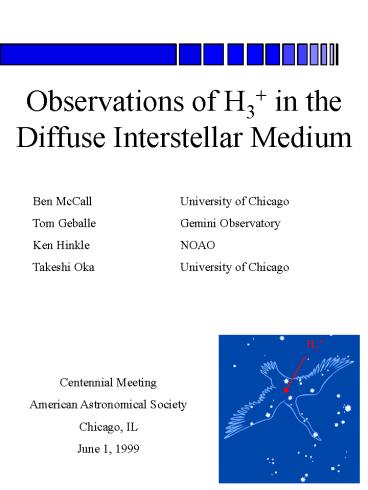H3 PowerPoint PPT Presentation
1 / 18
Title: H3
1
Observations of H3 in the Diffuse Interstellar
Medium
Ben McCall University of Chicago Tom
Geballe Gemini Observatory Ken
Hinkle NOAO Takeshi Oka University of Chicago
H3
Centennial Meeting American Astronomical
Society Chicago, IL June 1, 1999
2
Importance of H3
H3 is abundantly produced in the interstellar
medium through the cosmic-ray ionization of H2
H3 initiates a network of ion-neutral reactions,
which is responsible for most observed molecules
3
Dense Cloud Chemistry
Formation of H3
Rate ? n(H2)
Destruction of H3
Rate kCO n(H3) n(CO)
Steady State
( 10-4 cm-3)
4
H3 in Dense Clouds
1 parsec
104105 cm-3
2550 K
Agreement with canonical dense cloud
values confirms ion-neutral reaction scheme.
McCall, Geballe, Hinkle, Oka ApJ, Sep. 1, 1999
5
Galactic Center
Npara 5.1(1.7) 1014 cm-2 Northo 2.4(1.1)
1014 cm-2 Nbroad 17.5(3.9) 1014 cm-2
Geballe, McCall, Hinkle, Oka ApJ, 510, 251
(1999)
6
Cygnus OB2 12
observed at Kitt Peak
observed at UKIRT
Npara 2.4(3) 1014 cm-2 Northo 1.4(2)
1014 cm-2
Similar column density to dense clouds!!
McCall, Geballe, Hinkle, Oka Science 279, 1910
(1998)
7
About Cyg OB2 12
? d 1.7 kpc ? ? 80, b 0 ? AV 10 mag ?
N(H) 2 1022 cm-2 ? MV -10 mag! ? spectral
type B5Ie ? stellar wind 1400 km/s ? no 3.08
µm ice feature ? no dense clouds ? strong 3.4 µm
C-H band ? diffuse clouds ? CH, C2 observations
suggest n 300 cm-3
Morgan, Johnson, Roman PASP 66, 85 (1954)
8
Is it Really Diffuse?
? Absence of 3.08 ?m ice feature ? Presence of
3.4 ?m band ? N(CO)/N(?C) lt 5
N(CO) few 1016 cm-2
9
Maybe Partly Diffuse?
Suppose we put all of the observed CO in a
dense cloud can this cloud explain the H3
absorption?
N(CO) few 1016 cm-2 ? N(H2) few 1020
cm-2 n(H3) 10-4 cm-3 and N(H3) 4 1014
cm-2 ? L 4 1018 cm ? n(H2) 100 cm-3 Not
a dense cloud density! ??
10
Diffuse Cloud Chemistry
Formation of H3
Rate ? n(H2)
Destruction of H3
Rate ke n(H3) n(e-)
Steady State
11
Diffuse Cloud Results
Adopted Constants ? 3 10-17 s-1 ke 2 10-7
cm3 s-1 f(H2) 1/4 H/C 104
But N(H3) 4 1014 cm-2 ? so L 1021 cm 300
pc!
Seems unreasonably long...
12
Cygnus OB2 Association
10 arcmin 5 parsecs
13
Cyg OB2 5 Spectrum
Atmosphere
CH4
CH4
Cyg OB2 12
N 2.3(3) 1014 cm-2
N 2.0(5) 1014 cm-2
Cyg OB2 5
Same N(H3) and same vLSR 2.5 pc away
14
Whats Up?!?!?
Given the expressions for the number density and
path length of H3
There are three possibilities
We must accept the long path of 300 pc or The
laboratory rate constant ke is wrong or The
ionization rate ? is wrong
15
Long Path Unreasonable
For N(H2) 2 1022 cm-2 (inferred from EB-V
and X-ray spectral analysis),
20 cm-3
This low density is inconsistent with the
observed CO distribution from infrared and
millimeter-wave spectroscopy, which suggest n
4002000 cm-3
16
Electron Recombination
The experimental determination of the rate
constant for the dissociative recombination of
H3 has been a matter of some controversy. For a
long time, everyone thought 10-7 cm3 s -1 Then
Adams Smith said lt 210-8 cm3 s -1 Then Adams
Smith said 10-11 cm3 s -1 Then Amano said
10-7 cm3 s -1 Today, storage ring methods have
been used to prepare H3 exclusively in its v0
state, providing a very clean determination of ke
and a value of 210-7 cm3 s-1
(but theory still disagrees, giving a low ke)
17
The Mysterious ?
The H2 ionization rate ? is not well-determined
in diffuse clouds, but has generally been assumed
to be the same as in dense clouds (3 10-17 s
-1). There are three possible ways to increase ?
1. UV ionization IP(H2) 15.4 eV gt 13.6
eV 2. X-irradiation LX ? 1035 erg s -1 3.
Low-energy cosmic-rays?
If ? is a factor of 30100 higher in diffuse
clouds, then n(H2) 6002000 cm-3, L 310 pc,
and n(H3) 10-6 410-5 cm-3
18
Impact of H3
Dense Clouds
Path length H2 number density Kinetic
temperature Confirmation of ion-neutral scheme
Diffuse Clouds
Apparently long path lengths New physics
(ke) or New astrophysics (?)

